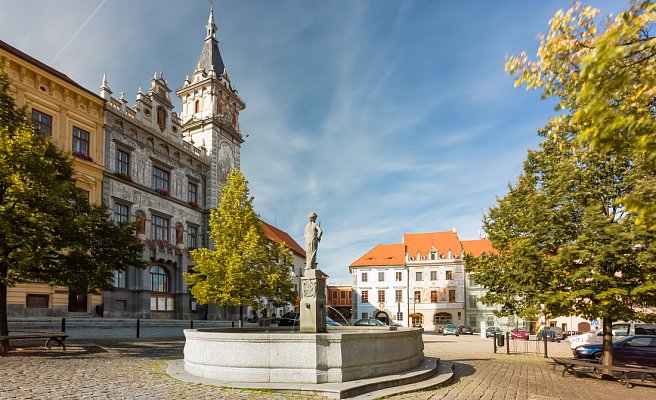
Kratochvíle Castle
The Kratochvíle Castle was an unprecedented construction in the middle of the 16th century. It was a sign of the ostentatious generosity of Vilém of Rožmberk and represents a gem of building and decorative art of the Renaissance period. The tours around the castle are focused on presentation of valuable decorations of the Renaissance interiors. Great attention is given to the Renaissance architecture, Mannerist artifi cial decoration of the premises, and fi gural stucco decorations. www.zamek-kratochvile.eu
Tip for an experience
The area near Lhenice is known as „The Garden of South Bohemia“ for its fruit orchards. Fruit growing has had long tradition here and the place is home for variety of fruit products.
TOP cultural events
Divadelní léto na Zámek Kratochvíle (Theater Summer at the Kratochvíle Castle), every year at the turn of June and July
Hradozámecká noc na Zámek Kratochvíle (Night of Castles at the Kratochvíle Castle), every year in August
Town of Prachatice
The town was established on a medieval trade route known as the “Golden Path”, which was used to transport salt from Austrian mines to Bohemia. Prachatice is one of the best-preserved town complexes in the Czech Republic. The historical center kept its Renaissance look inside a ring surrounded by preserved town walls from the 14th century. The historical development of the town is shown in an exhibition in the Prachatice Museum. Prachatice is related to the worldfamous church reformer and preacher Master Jan Hus, who is said to had lived during his studies in house no. 71, currently called Hus house. His native house is situated in nearby Husinec. www.prachatice.eu
Tip for an experience
The picturesque village of Husinec bears the name of the signifi cant church reformer Jan Hus. Visit his native house with an exhibition called “The Life and Work of Master Jan Hus”.
TOP cultural events
Historické slavnosti Zlaté solné stezky (Historical Festival of the Golden Salt Path) in Prachatice, every year in June
Festival Piva (Beer Festival) in Prachatice, every year in August.
Town of Volary
For centuries, the development of the town was infl uenced and supported by the presence of the trade route known as the “Golden Path” leading from Passau to Prachatice and to the inland. The first written mention of Volary comes from 1359. The unique features of the town include timbered homes in the Alpine style, some of which are open to the public. You will learn more about the history and current situation of the town during a visit to the Volary Museum, located in one of the traditional timbered houses. www.mestovolary.cz
Tip for an experience
Visit the nearby municipality of Lenora, where bread is baked during the summer months in the municipal furnace built in 1837. Delicious fl at breads, bread rolls, and bread are gradually put in the furnace and distributed for free to all visitors of the public baking to taste. A technical monument called the Lenora Rechle is located near Lenora.
TOP cultural events
Volarský sekáč (Volary Mower) in Volary, every year in July
Volarské slavnosti dřeva (Volary Wood Festival) in Volary, every year in August
Town of Vimperk
Its romantic location on the promontory above the Volyňka River, the picturesque silhouette of the castle on a high hill, town walls, a tall tower of the church of the Annunciation of Virgin Mary, and a collection of ancient houses all contribute to the character of Vimperk as a medieval town. As early as in the 13th century, a fortress was built in the thick Šumava forests above the Volyňka River, later rebuilt to a castle. In 1479, Vimperk was promoted to a town, which developed and became rich mainly thanks to its salt trading aft er “new branch” of the Vimperk Golden Path was opened. The town and its surroundings were famous for the production of glass that had developed here since the 14th century. Book printing was another signifi cant industrial sector and made the town famous in the 19th century. www.vimperk.cz
Tip for an experience
Visit the natural reservation of Boubínský prales, a primeval forest, and enjoy a beautiful view of the Šumava forests from the Boubín Observation Tower.
TOP cultural events
Setkání dřevosochařů (Meeting of Wood Sculptors) in Vimperk, every year in July. Bitva o Winterberg (Battle of Winterberg) in Vimperk, every year in August.
Šumava National Park
The Šumava National Park is the largest national park in the Czech Republic. It consists of a continuous complex of forests in Central Europe and it is therefore oft en known as the “green roof of Europe”. Those who enjoy spending their free time actively and lovers of beautiful nature and overwhelming sceneries will love this place. Set out on a trip from Kvilda to the source of the national Vltava River, which is located on the hillside of the Black Mountain, 1,190 m above sea level. You can reach this place on foot using the blue-marked tourist path, by bike, or using the national park green buses during the summer months. www.npsumava.cz
Tip for an experience
If you are interested in living in wilderness, travel to the Visitor Center of the Šumava National Park at Kvilda and learn more about the life of deer game and lynxes.
TOP cultural event
Šumavský skimaraton (Šumava Ski Marathon) at Kvilda, every year in February
Oslavy konce 2. světové války (Celebrations of the end of World War II) at Kvilda, every year in April